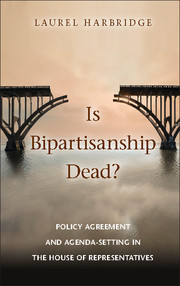Book contents
- Frontmatter
- Contents
- List of figures and tables
- Acknowledgments
- 1 Introduction
- 2 A Puzzle of Declining Bipartisanship
- 3 Strategic Partisan Agenda-Setting
- 4 Agenda-Setting and the Decline of Bipartisan Cooperation
- 5 Variation in Strategic Partisan Agenda-Setting
- 6 Strategic Partisan Agenda-Setting Across Policy Areas
- 7 District Responsiveness and Member-Party Relationships
- 8 The Past, Present, and Future of Bipartisanship
- Appendix
- References
- Index
3 - Strategic Partisan Agenda-Setting
A Theoretical Framework
Published online by Cambridge University Press: 05 March 2015
- Frontmatter
- Contents
- List of figures and tables
- Acknowledgments
- 1 Introduction
- 2 A Puzzle of Declining Bipartisanship
- 3 Strategic Partisan Agenda-Setting
- 4 Agenda-Setting and the Decline of Bipartisan Cooperation
- 5 Variation in Strategic Partisan Agenda-Setting
- 6 Strategic Partisan Agenda-Setting Across Policy Areas
- 7 District Responsiveness and Member-Party Relationships
- 8 The Past, Present, and Future of Bipartisanship
- Appendix
- References
- Index
Summary
At any given point in time, bipartisan voting patterns in the House can reflect two distinct, but not mutually exclusive, underlying conditions. Bipartisan votes can be the result of members having similar preferences on all bills, or they can result from a selection process that privileges votes for bills with cross-party support. Likewise, the decline of bipartisan cooperation in voting patterns can be caused either by increased polarization of member preferences across issues and bills or a floor agenda that is increasingly skewed toward partisan legislation, or both. The evidence in this book points to agenda-setting as an overlooked component of declining bipartisanship. For example, in the wake of the Enron scandal, the Republican leadership’s choice to pursue the partisan version of pension reform legislation despite the presence of a bipartisan alternative suggests the importance of agenda-setting. Similarly, the increase in bipartisan voting between the 104th and 105th Congresses, despite relatively few changes in membership (and therefore preferences), can only be caused by a change in the agenda. Finally, the relative lack of decline in bipartisan cooperation in cosponsorship coalitions over time also cautions against a purely preference-driven story as members from both parties continue to find common ground on legislation at this pre-agenda-setting stage. All of this suggests that agenda-setting is important for explaining the rise of partisan conflict in Congress.
This chapter explicates why the agenda is important for understanding the decline of bipartisanship, and how leadership considerations produce tensions between bipartisan and partisan legislation that vary across contexts. How the leadership resolves this tension determines the type of agenda that is pursued. The primary goal of this chapter and those subsequent to it is not to explain or test every facet of agenda-setting, but rather to explain why the extent of bipartisan agenda-setting has shifted over time. To do so, I draw on key insights about the considerations that confront leaders setting the agenda, developing hypotheses about the conditions under which bipartisan or partisan agenda-setting is pursued. Ultimately, I propose that the agenda has changed over time in a way that precludes bipartisan cooperation and manufactures partisan conflict. I call this process strategic partisan agenda-setting.
- Type
- Chapter
- Information
- Is Bipartisanship Dead?Policy Agreement and Agenda-Setting in the House of Representatives, pp. 42 - 61Publisher: Cambridge University PressPrint publication year: 2015



